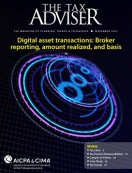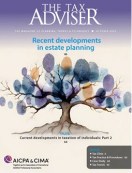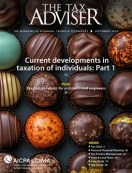- newsletter
- TAX INSIDER

Capital contribution of reduced basis S corporation debt
This method provides a practical alternative to a taxable repayment.
Please note: This item is from our archives and was published in 2018. It is provided for historical reference. The content may be out of date and links may no longer function.
Related
Filing a timely S election
Loan guarantee does not increase S corp. shareholder’s debt basis
Shareholder cannot unilaterally change an S corp.’s election
According to the IRS Statistics of Income website, there are more Forms 1120S, U.S. Income Tax Return for an S Corporation, filed than any other business entity (4.6 million S corporation returns were filed in 2014, compared with 3.8 million partnership returns and 2.2 million corporate returns (IRS Data Book, 2014, Table 2)).
While the S corporation has many of the same passthrough characteristics of the runner-up for entity choice, the partnership, a major difference is the rules governing the passthrough of losses to owners. Generally, losses of the S corporation are passed through to the shareholders to the extent the shareholder has basis in her stock and, once all stock basis is exhausted, to the extent the shareholder has basis in debt to the corporation. It is important to note that stock basis is used first and then losses may pass through to the extent that the shareholder has made a loan directly to the corporation.
Guarantees are generally not considered debt for these purposes unless and until the shareholder makes payment on the debt to a third party. These rules differ from the rules for passing through losses from a partnership to its partners, which are available to the extent of the partner’s outside basis and include a partner’s share of partnership liabilities.
Any S corporation losses in excess of these stock and debt bases are carried over indefinitely until there is sufficient basis to pass the losses through to the shareholder. Generally, basis is restored by a shareholder’s capital contribution or the passthrough of income items to the shareholder. In a year subsequent to a year with excess losses, the S corporation may pass through current year income or gains as well as prior-year carryover losses. When restoring basis, the shareholder will generally first restore basis in the debt to the extent of the amount owed, and then restore basis in the stock.
In a year when basis adjustments are a net increase, meaning all positive adjustments (contributions, income, and gains) are greater than negative adjustments (distributions and losses), Sec. 1367(b)(2)(B) provides the taxpayer should first apply the net increase to the debt basis and the balance of positive adjustments to stock. This is referred to as the “net increase approach.” This rule provides the taxpayer with enough stock basis to make distributions tax-free during the year. Unlike a loss passthrough, distributions are only tax-free to the extent the shareholder has basis in the stock. Debt basis cannot be used to make tax-free distributions after stock basis is reduced to zero. Thus, a shareholder increases stock basis to the extent of distributions and losses, while increasing debt basis by the excess positive adjustments.
The repayment of debt, while typically a tax-free recovery of capital, will result in gain if the basis is less than the amount owed. If the debt is evidenced in writing, the gain will be capital. Otherwise, it is ordinary. If, for example, a taxpayer has a $100,000 note with a basis of $50,000 and the S corporation repays $50,000 in principal, the shareholder will have a capital gain of $25,000 on the repayment. This is because under Rev. Rul. 64-162, the shareholder cannot designate the entire payment as basis recovery; rather the recovery of capital is allocated proportionate to the basis and face value of the note ($50,000 repayment × $50,000 basis ÷ $100,000 owed), similar to the rules used in the installment sales method.
A workaround
While seemingly straightforward, the S corporation loss limitation rules can present taxpayers with unique dilemmas. The following describes a possible workaround and related precautions when basis in debt is less than the amount owed, i.e., the “adjusted issue price” as determined under Regs. Sec. 1.1275-1(b). Specifically, the shareholder may make a capital contribution of reduced basis debt to the corporation. As you will see, making a capital contribution of debt to the corporation will increase the stock basis for the shareholder. This increase allows for additional tax-free distributions and is generally preferable to the proration of debt repayments under Rev. Rul. 64-162.
The capital contribution of debt may be treated under Sec. 351 or as a sale or exchange. For Sec. 351 to apply, the debt must be property. This generally means the debt is evidenced by writing (Sec. 351(d)(2)). Under Sec. 351, the contribution will be tax-free if the shareholder contributes property (note) in exchange for S corporation stock and the shareholder has control of the corporation immediately after the exchange. Control is a two-part test and is defined in Sec. 368(c) as 80% or more of both voting and all other classes of stock.
As a result of the Sec. 351 transaction, the shareholder will increase stock basis, which was zero, by the adjusted basis in the debt. If the issuance of additional stock would be a meaningless gesture, e.g., the shareholder owns 100% of the S corporation, additional shares need not be issued. However, if there is more than one shareholder and a shareholder contributes debt to the corporation while not receiving stock in exchange, there may be a deemed gift to the other shareholders as the value of their interest in the corporation has increased.
If the Sec. 351 requirements are not met, the general rule of Sec. 1001 will apply. Here, the tax treatment of the sale or exchange depends on whether the debt is in writing. If the debt is in writing, the shareholder is treated as having received an amount realized equal to the fair market value (FMV) of the S corporation stock. If that amount is greater than the adjusted basis in the debt, the shareholder recognizes a capital gain. If the amount is less than the shareholder’s debt basis, the shareholder may be disallowed the loss under the Sec. 267 related-party rules.
Under Sec. 267(b)(2), an individual shareholder and corporation are related parties when the individual owns more the 50% of the outstanding stock, directly or indirectly. Whether the 50% is measured prior to or after the contribution of debt is not entirely clear in Regs. Sec. 1.267(a)-1(a). In the absence of the application of Sec. 267, the shareholder’s loss is capital. In all circumstances, the initial basis in the newly received stock is its FMV at the time of the exchange.
When the debt is not in writing, i.e., an open account, the transfer of stock to the shareholder is treated as payment on the open account in an amount equal to the FMV of the stock. The shareholder will have ordinary income or loss depending on the stock’s FMV as compared to the basis in corporate debt. Similar treatment results when replacing an open account with a note, which is a taxable exchange under Regs. Sec. 1.1001-3. However, the gain may be recognized under the installment sales method. Given the capital character of the gain and the potential to draft a note within the straight-debt safe harbor guidelines of Sec. 1361(c)(5), which reduce the risk of having the debt be recharacterized as a second class of stock resulting in the inadvertent termination of S status, it is advisable to put shareholder loans in writing. The challenge, as many practitioners can attest, is when shareholders seek tax services after an open account liability has been in place for some time.
If the stock is received in full satisfaction of the debt, the S corporation may have cancellation-of-debt income. Under Sec. 108(e)(6), the corporation is treated as satisfying the debt with money equal to the shareholder’s basis in the debt, not adjusted for income and loss items of the S corporation that have previously passed through to the shareholder. Thus, the contribution will rarely result in cancellation-of-debt income because the basis in the debt will likely equal the amount owed. Additionally, if the value of the stock is less than the adjusted basis in the debt, the shareholder may have a bad debt deduction under Sec. 166.
Nonbusiness bad debts are treated as a short-term capital loss and are subject to the netting rules seen on Schedule D, Capital Gains or Losses, of Form 1040, U.S. Individual Income Tax Return, and the $3,000 maximum (unindexed) net capital loss deduction. Business bad debts are ordinary losses and thus are generally preferable. Under Sec. 108(e)(7), however, gain on the sale of stock acquired for debt where an ordinary loss was incurred by the shareholder will be subject to Sec. 1245 recapture.
A final consideration is the net investment income tax. If a shareholder does not materially participate in the S corporation’s business, any gain on the satisfaction of the note is investment income for purposes of the 3.8% net investment income tax.
The passthrough of S corporation losses to the extent of the shareholder’s basis in his or her stock and debt can be beneficial; however, the resulting reduced basis debt may lead to taxable income on repayment of the debt. Shareholders may wish to consider contributing the reduced basis debt to the corporation as a tax-efficient alternative to taxable repayments of the debt.
Andrew M. Brajcich is an associate professor of accounting in the School of Business Administration at Gonzaga University in Spokane, Wash. To comment on this article or to suggest an idea for another article, please contact Sally Schreiber, senior editor, at Sally.Schreiber@aicpa-cima.com.














